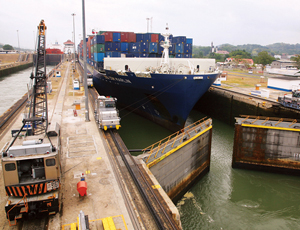When U.S. engineer John Frank Stevens arrived in Panama in July 1905 to take over the American effort to construct the Panama Canal, he was appalled. The endeavor to build the transoceanic waterway already was a year old and had consumed more than $128 million. “I found no organization…no answerable head who might delegate authority…no cooperation existing between what might charitably be called the departments,” Stevens wrote, as reported in David McCullough’s watershed book “The Path Between the Seas.”
Stephens, who gained fame for supervising the construction of the Great Northern Railway over the Continental Divide in Washington state, brought work to a complete halt until the logistics were overhauled. “Digging is the least thing of all,” he said.
That is a lesson the Panama Canal Authority (ACP) has taken to heart today as it moves forward with a $5.25-billion push to expand the waterway. When the expansion is completed in 2014, the 80-kilometer-long waterway will double in capacity, allowing for an increased number of vessels as well as the ability to permit the passage of post-Panamax ships. Most container cargoes currently transit through the canal on so-called Panamax-sized vessels. The volume—294.13 m long, 32.31 m wide and a draft of 12.04 m—is designed to take up every available bit of space in the locks while carrying a maximum of 5,000 20-ft equivalent units, or TEUs (ENR 4/30/07).
The proposed third set of locks will employ sliding gates similar to those at the Barendregt canal in Amberes, Belgium, and a series of water saving basins used in Germany. ACP chose to integrate both the Atlantic and Pacific locks into a single design-build contract in order to ensure consistency in the final product.
The single-lane, three-step set of locks will consist of lock chambers measuring 427 m long x 55 m wide x 18.3 m deep. ACP’s preliminary estimate for the locks expansion was $3.35 billion, although the actual cost of each specific bid remains confidential until the technical aspects of the proposals are complete.
Four consortiums comprising 30 companies qualified last December, but only three chose to submit bids in March: Consorcio C.A.N.A.L., led by ACS Servicios, Comunicaciones y Energía, S.L. of Spain; Bechtel, Taisei, Mitsubishi Corp., led by U.S.-based Bechtel International Inc.; and Grupo Unidos por el Canal, led by Spain’s Sacyr Vallehermoso S.A.
An ACP committee currently is reviewing the technical aspects of the submitted designs. The prices are secured in the vault of a Panamanian bank until the review is completed. ACP estimates the contract will be awarded in July.
The quasi-governmental agency has spent nine months organizing project management in conjunction with Englewood, Colo.-based construction giant CH2M Hill Cos. In anticipation of the scale of the locks effort, CH2M Hill and ACP have created an intricately integrated system that boasts a representative from each organization in place at almost every level of the management team.
“We have almost a century of experience with working with the canal. We know the geology and hydrology and every detail of its maintenance better than anyone,” says ACP engineering and programs management Executive Vice President Jorge L. Quijano. “We wanted a situation where we could use our knowledge and bring in someone who knows how to manage an operation this large.”
Forging Partnerships
CH2M Hill won the program-manager contract last August, besting two other bidders: Parsons Brinckerhoff, New York City, and URS Holdings Inc., San Francisco. ACP used a “best value” evaluation that weighed the experience of the firms, particularly in terms of managing major design–build infrastructure works.
CH2M Hill’s primary focus is to help oversee the locks component, which comprises almost 60% of the effort. When completed, the new locks will allow passage of container ships capable of carrying almost 2.5 times...



Post a comment to this article
Report Abusive Comment